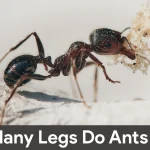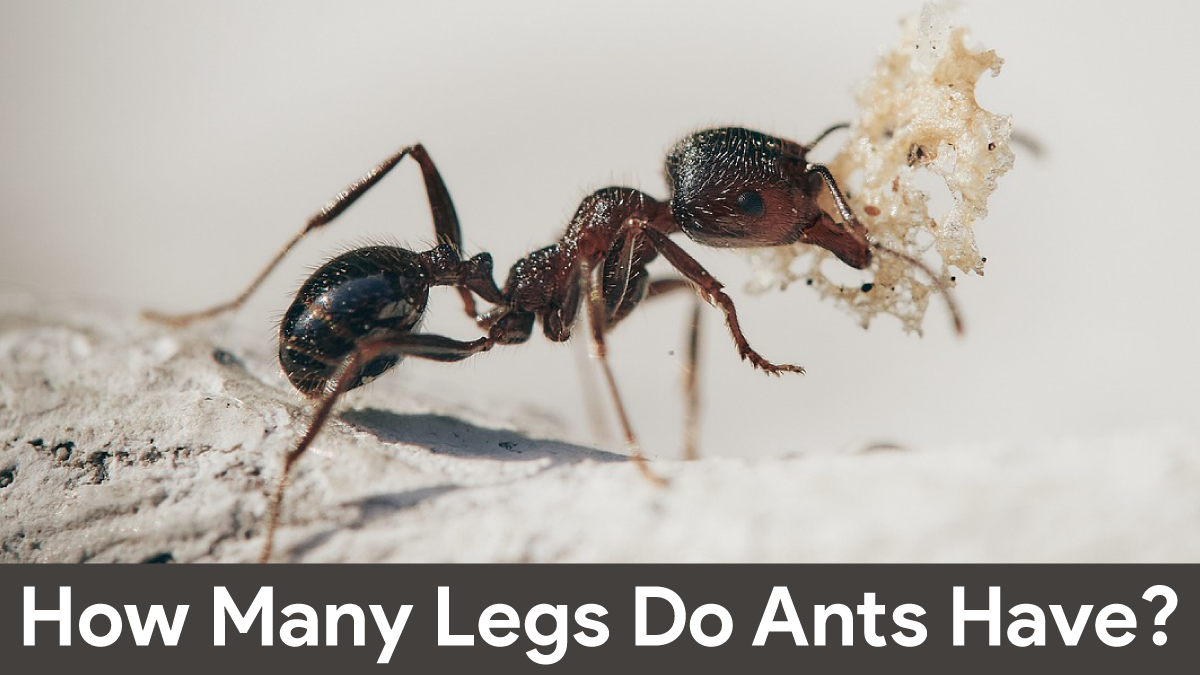Ants’ anatomy is a deep study, and you will discover many exciting and valuable facts about their body and organs. One frequently asked question about ants’ bodies is how many legs ants have. Like most other insects, ants also have six legs, or three pairs of legs from which one lies under the, and one, which lies under the abdomen and one between the head and abdomen.
Moreover, this article will discuss in detail the ants’ lungs, ears, and eyes, along with some discussion about whether ants have blood in their body. Ants who don’t have ears can hear the sounds and feel them. An ant’s body does not need blood to circulate the nutritious value of food around the body, as this is done by hemolymph fluid. Lastly, ants have eyes that are low in sight but can let the ants see and understand their directions clearly.
Table of Contents
How Many Legs Do Ants Have
Usually, Insects have six legs, and ants are also one of those insects that have six legs, two under the head, two under the abdomen, and two between these four legs. Though ants have some special functions with legs, they can move front and back legs in one direction while the middle ones can move in the opposite direction. Ants’ legs combine the tibia, tarsus, and femur. Legs are the primary and vital part of the ant’s body, enabling them to walk, run, touch, climb, groom, and even communicate with fellow ants through the vibration caused by the legs.
How Many Eyes Do Ants Have
Ants are very few creatures, and one wonders how such a tiny insect sees the world with its small eyes. However, first, it should be made clear that ants have eyes and can see their surroundings the same way other animals see. Likewise, ants also have compound eyes on the top of their head, which is good enough to let ants see things in their surroundings easily.
Compound And Ocelli Eyes
Compound eyes that ants have on their head are a combination of ocelli, antennae, and mandibles. The two compound eyes on the head of the ants are not the end of their story, though ants have some more eyes as well. The triangle of 3 eyes on the forehead of the ants is called ocelli. All the ants have their distinct tasks to carry out. Compound eyes on the head are for the sight of ants, and three triangle eyes on the forehead named ocelli work as the compass, which helps and guides ants about the directions while moving.
Size And Shape Of The Eyes
In general, the size and shape of the ant’s eye depend upon the type of ant. Yes, every other ant species has its kind of eye. Usually, the ants that roam around our houses and gardens frequently are the ones that have two big compound eyes on the head and three triangle-shaped ocelli eyes on the forehead. Though how much sight each species of ant has depends on the ommatidia in their eyes, the more the ommatidia means, the more company an ant or any other insect has.
However, the range of ants’ sight could be higher, and they mainly see things clearly that are very near to them. The rest of the objects, people, and dogs far away from their eyes or height are slurry things for them as they cannot exactly see them. Their sight range is limited and depends on ommatidia which enables them to see clearly. In the case of human beings, ants can smell and feel the existence of human beings, but humans are far more significant than ants, so they can never see them thoroughly, and transparently they see the part of them in a clear way which is near to their eyes.
Do Ants Have Ears
If we specifically talk about ants having ears, then the answer is very straightforward: No. Ants do not have ears, but it does not mean they cannot hear. Ants can listen to and can communicate even without the existence of ears. Let’s find out how;
How do Ants Communicate?
Ants are one of those lucky insects which possess the quality of hearing. Yes, ants can hear. This is a need for ants because they must live in colonies built with their efforts by applying division of labor, excessive communication, and discipline. Having ears does not mean that an animal or an insect whose ears are not visible hears similarly. But ants hear and communicate in different ways when compared to those animals who have clear and visible ears. Let’s explore the ears and hearing sense of the ants here.
How do Ants hear
This is something different and new to know. Ants communicate with their fellow colony members or ants in the form of vibration. Usually, all the colony members create the same beat when share communicate with their fellows, either while searching for food or alerting fellows of any pending danger. Moreover, it has also been discovered that, at times, ants rub their body parts to create vibrations; gaster pieces that lie between the abdomen are the main ones that they rub to make the beat for communication.
Ants have another way of communication: they create specific vibrations for danger only. In such circumstances, ants create vibration by drumming their abdomen, which is done inside their nest where they tap their stomach on the surface of the nest and let other fellows know there is danger around them. This task is then carried out by all the colony members who hear the vibration of drumming so that they can be heard by a maximum number of colony members and can successfully encounter the danger either by relocating somewhere else or by making some other ways of safety.
Do Ants Have Lungs
Ants do not possess lungs, but they still breathe and survive because they have more than one throat and around ten openings, allowing the air to pass in or pass out in another way. Let’s explore how ants breathe without lungs.
Breathe Without Lungs
Before jumping to the discussion regarding how ants breathe if they don’t have lungs, let’s take one natural test of yours, hold your chest for a while and then see if you can take a small breath. So the answer would be yes, you can breathe from the way of your throat, which can help pass out the air even if your chest is still and not functioning accordingly. This is the same way in which ants breathe without the existence of lungs in their body. Instead, ants have many other openings available in their body, which let them pass in or out the air from the body, and they don’t have lungs for this function. Tough, this is called the diaphragm, in which the body passes in or passes out air without lungs and teeth. Human bodies and other giant creatures can not breathe this quickly and survive without lungs.
How Does It Work?
When there are no lungs in the body, spiracles must be available to function as lungs do. Ants have tiny bodies, which we all know, and have more than one throat, which is why ants can survive without lungs. Trachea means that every individual spiracle available in ants is attached to the tubes, which then function as the lungs. One more abnormal fact is that the trachea does not need blood to perform with the body’s oxygen. There, the trachea makes its way inside the body by spreading all along and making the ending of each branch in a cul-de-sac, which enables the moist conclusion and leads towards the end of the membrane cell directly.
Do Ants Have Blood
Ants are everywhere, and many times, unintentionally, every other human being has crushed an ant. Though, there may be very few notices that when an ant is being destroyed, nothing like red blood comes out. Have you ever thought about why this happens? Does this state that an ant’s body does not have blood, or maybe they have blood that is not red, which is the color of the blood in our concepts? Well, let’s find out the answers to all these questions.
Why There Is No Red Blood?
Whenever you see an ant crushed, some fluid comes out, either yellowish or greenish but not red. This pops up the question in the human mind: where is the ant’s blood? Well, that fluid is called hemolymph. Hemolymph is found in, and instead of blood, blood is required in the body to carry out all the nutritious value from the food to supply to other body parts. As discussed earlier in the article, ants do not have lungs, and they either don’t need blood which spreads oxygen around the body. This further added evidence to the fact that ants do not have blood which is why other body organs are also working accordingly without the need to have blood.
Hemolymph Vs. Blood
Ants have hemolymph in their body instead of a blood color of blood red because it contains red blood cells, so many people get confused about it. Maybe hemolymph is the same as blood but is not red because the ants’ body does not contain red blood cells. Well, this needs to be clear, hemolymph is not blood as number one, it’s not red, and number two, it does not supply the body of ants with oxygen. Though, hemolymph is just a fluid that helps the nutrition values of food to move around the body of ants the way blood does in humans or other animals’ bodies.
FAQs
How many legs do ants have?

Ants have six legs in total.
Do ants have ears?
No, ants do not have ears, but they can hear.
Can ants see?
Yes, ants have five eyes through which they can see the world.
How do ants communicate?
Ants communicate with fellow ants through vibration, which they make using their body parts.
Do ants have blood in their body?
No ants do not have blood in their body. Instead, they have hemolymph fluid.
Conclusion
In light of the above discussion, how many legs do ants have? A conclusion can be drawn that, though ants have one month of a creature with many things to discuss, they have six legs. Thus, ants do not have lungs, but they breathe without them; ants do not have ears, but they can still hear and have a very distinctive and unknowingly impressive way of communicating with fellow ants, and that is they make vibrations with the help of their body and use it as a means of communication. In contrast, ants have five eyes in total; two are compound eyes on the head, and three are ocelli eyes that lie on the forehead of the ants. The blood is missing from ants’ bodies, but they have hemolymph fluid in their body, which helps to move the nutritious value of food around the body.
